Interactions of tryptophan, tryptophan peptides, and tryptophan alkyl esters at curved membrane interfaces
- PMID: 17002272
- PMCID: PMC2568979
- DOI: 10.1021/bi0608414
Interactions of tryptophan, tryptophan peptides, and tryptophan alkyl esters at curved membrane interfaces
Abstract
Motivated by ongoing efforts to understand the mechanism of membrane protein crystallogenesis and transport in the lipidic cubic phase, the nature of the interaction between tryptophan and the bilayer/aqueous interface of the cubic phase has been investigated. The association was quantified by partitioning measurements that enabled the free energy of interaction to be determined. Temperature-dependent partitioning was used to parse the association free energy change into its enthalpic and entropic components. As has been observed with tryptophan derivatives interacting with glycerophospholipid bilayers in vesicles, tryptophan partitioning in the cubic phase is enthalpy driven. This is in contrast to partitioning into apolar solvents, which exhibits the classic hydrophobic effect whose hallmark is a favorable entropy change. These results with tryptophan are somewhat surprising given the simplicity, homogeneity, and curvature of the interface that prevails in the case of the cubic phase. Nevertheless, the interaction between tryptophan and the mesophase is very slight as revealed by its low partition coefficient. Additional evidence in support of the interaction was obtained by electronic absorption and fluorescence spectroscopy and fluorescence quenching. Partitioning proved insensitive to the lipid composition of the membrane, examined by doping with glycerophospholipids. However, the interaction could be manipulated in meaningful ways by the inclusion in the aqueous medium of salt, glycerol, or urea. The effects seen with tryptophan were amplified rationally when measurements were repeated using tryptophan alkyl esters and with tryptophan peptides of increasing length. These findings are interpreted in the context of the insertion, folding, and function of proteins in membranes.
Figures
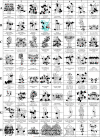


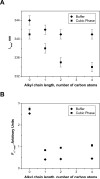
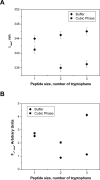

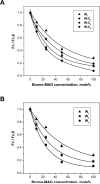

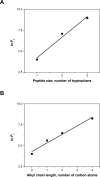

Similar articles
-
Folding of beta-sheet membrane proteins: a hydrophobic hexapeptide model.J Mol Biol. 1998 Apr 17;277(5):1091-110. doi: 10.1006/jmbi.1998.1640. J Mol Biol. 1998. PMID: 9571025
-
Membrane partitioning: "classical" and "nonclassical" hydrophobic effects.J Membr Biol. 2011 Jan;239(1-2):5-14. doi: 10.1007/s00232-010-9321-y. Epub 2010 Dec 8. J Membr Biol. 2011. PMID: 21140141 Free PMC article.
-
Thermodynamics of partitioning of substance P in isotropic bicelles.J Pept Sci. 2009 May;15(5):353-8. doi: 10.1002/psc.1121. J Pept Sci. 2009. PMID: 19189270
-
Membrane States of Saturated Glycerophospholipids: A Thermodynamic Study of Bilayer Phase Transitions.Chem Pharm Bull (Tokyo). 2019;67(4):300-307. doi: 10.1248/cpb.c18-00954. Chem Pharm Bull (Tokyo). 2019. PMID: 30930432 Review.
-
Hydrophobic interactions of peptides with membrane interfaces.Biochim Biophys Acta. 1998 Nov 10;1376(3):339-52. doi: 10.1016/s0304-4157(98)00021-5. Biochim Biophys Acta. 1998. PMID: 9804985 Review.
Cited by
-
LCP-Tm: an assay to measure and understand stability of membrane proteins in a membrane environment.Biophys J. 2010 Apr 21;98(8):1539-48. doi: 10.1016/j.bpj.2009.12.4296. Biophys J. 2010. PMID: 20409473 Free PMC article.
-
Tryptophan residues promote membrane association for a plant lipid glycosyltransferase involved in phosphate stress.J Biol Chem. 2011 Feb 25;286(8):6669-84. doi: 10.1074/jbc.M110.138495. Epub 2010 Dec 14. J Biol Chem. 2011. PMID: 21156807 Free PMC article.
-
Life at the border: adaptation of proteins to anisotropic membrane environment.Protein Sci. 2014 Sep;23(9):1165-96. doi: 10.1002/pro.2508. Epub 2014 Jul 2. Protein Sci. 2014. PMID: 24947665 Free PMC article. Review.
-
ConoGPT: Fine-Tuning a Protein Language Model by Incorporating Disulfide Bond Information for Conotoxin Sequence Generation.Toxins (Basel). 2025 Feb 17;17(2):93. doi: 10.3390/toxins17020093. Toxins (Basel). 2025. PMID: 39998110 Free PMC article.
-
A comprehensive review of the lipid cubic phase or in meso method for crystallizing membrane and soluble proteins and complexes.Acta Crystallogr F Struct Biol Commun. 2015 Jan 1;71(Pt 1):3-18. doi: 10.1107/S2053230X14026843. Epub 2015 Jan 1. Acta Crystallogr F Struct Biol Commun. 2015. PMID: 25615961 Free PMC article. Review.
References
-
- Lee AG. Ca2+ -ATPase structure in the E1 and E2 conformations: mechanism, helix-helix and helix-lipid interactions. Biochim. Biophys. Acta. 2002;1565:246–266. - PubMed
-
- Kachel K, Asuncion-Punzalan E, London E. Anchoring of tryptophan and tyrosine analogs at the hydrocarbon-polar boundary in model membrane vesicles: parallax analysis of fluorescence quenching induced by nitroxide-labeled phospholipids. Biochemistry. 1995;34:15475–15479. - PubMed
-
- Yau WM, Wimley WC, Gawrisch K, White SH. The preference of tryptophan for membrane interfaces. Biochemistry. 1998;37:14713–14718. - PubMed
Publication types
MeSH terms
Substances
Grants and funding
LinkOut - more resources
Full Text Sources
Research Materials

